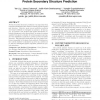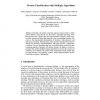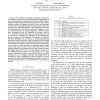92
Voted
SIGIR
2004
ACM
15 years 6 months ago
2004
ACM
Protein secondary structure prediction is an important step towards understanding the relation between protein sequence and structure. However, most current prediction methods use...
94
Voted
PCI
2005
Springer
15 years 6 months ago
2005
Springer
Nowadays, the number of protein sequences being stored in central protein databases from labs all over the world is constantly increasing. From these proteins only a fraction has b...
87
Voted
SAC
2005
ACM
15 years 6 months ago
2005
ACM
There are today several systems for predicting transmembrane domains in membrane protein sequences. As they are based on different classifiers as well as different pre- and post-p...
CIBCB
2005
IEEE
15 years 6 months ago
2005
IEEE
— Part of the challenge of modeling protein sequences is their discrete nature. Many of the most powerful statistical and learning techniques are applicable to points in a Euclid...
107
click to vote
BIBE
2007
IEEE
15 years 7 months ago
2007
IEEE
Abstract—We consider the problem of aligning multiple protein sequences with the goal of maximizing the SP (Sum-of-Pairs) score, when the number of sequences is large. The QOMA (...
93
Voted
BIBE
2007
IEEE
15 years 7 months ago
2007
IEEE
—The rapid burgeoning of available protein data makes the use of clustering within families of proteins increasingly important, the challenge is to identify subfamilies of evolut...
SP
2008
IEEE
15 years 7 months ago
2008
IEEE
Many basic tasks in computational biology involve operations on individual DNA and protein sequences. These sequences, even when anonymized, are vulnerable to re-identification a...
AINA
2008
IEEE
15 years 7 months ago
2008
IEEE
The common-use gap penalty strategies, constant penalty and affine gap penalty, have been adopted in the traditional three-sequence alignment algorithm which considers the inserti...
114
Voted
SAC
2009
ACM
15 years 7 months ago
2009
ACM
Signal finding (pattern discovery) in biological sequences is a fundamental problem in both computer science and molecular biology. Many approaches have been proposed for extract...
DCC
2006
IEEE
16 years 20 days ago
2006
IEEE
We consider the problem of compressibility of protein sequences. Based on an observed genome-scale long-range correlation in concatenated protein sequences from different organism...



